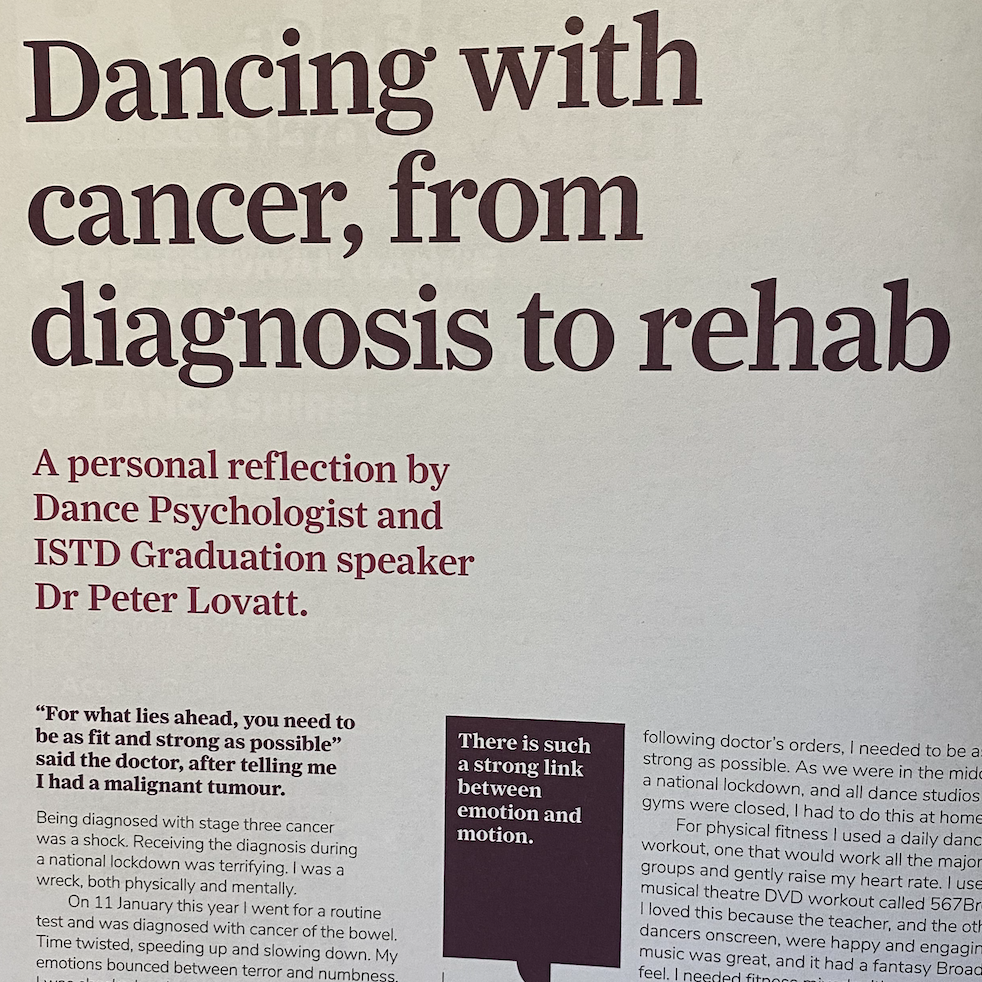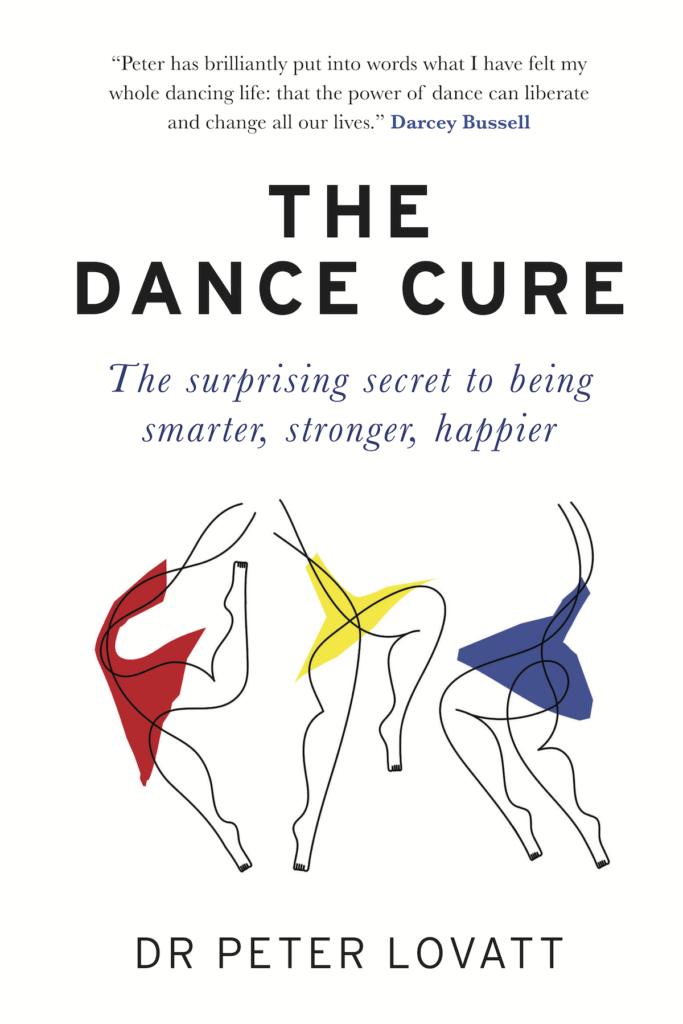

On the 11th January this year I went for a routine test and was diagnosed with cancer of the bowel. Time twisted, speeding up and slowing down. My emotions bounced between terror and numbness. I was shocked and scared. My body tensed, creating a useless armour, and I wanted to run away, or do nothing, to freeze in sedentary fear.
These were not the perfect conditions in which to dance. But dancing was, I knew, the thing I had to do. There is abundant evidence that dancing changes the way people think, feel and behave. Science has shown what dancers have known for centuries, that dancing can lead to positive changes in our physical and mental wellbeing.
Right now, I needed to create changes in my physical and mental wellbeing. So, I danced.
I didn’t know it at the time, but I had three weeks between diagnosis and surgery and, following doctor’s orders, I needed to be as fit and strong as possible. As we were in the middle of a national lockdown, and all dance studios and gyms were closed, I had to do this at home.
For physical fitness I used a daily dance workout, one that would work all the major muscle groups and gently raise my heart rate. I used a musical theatre DVD workout called 567Broadway. I loved this because the teacher, and the other dancers onscreen, were happy and engaging, the music was great and it had a fantasy Broadway feel. I needed fitness mixed with escapism.
On top of the cardio-vascular benefits of dancing daily, I needed to get out of my head. I was spending too much time catastrophising, thinking about the worst-case scenario of cancer, imagining how my 7 year old son would grow up without his father. 567Broadway gave me 30 minutes a day free from these thoughts. I’d turn the music up loud, I’d be on that Broadway stage, and, sometimes through a veil of tears, with the help of “ONE! Singular sensation” I’d escape from my negative thoughts.
For physical connection I danced with my wife. We held each other, we breathed in time, and we moved in synchrony. Fear and loneliness seemed to dissipate with an embrace.
For moments of physical and mental calm, order and discipline, I did a daily ballet class. Many years ago I went on the ISTD Cecchetti Summer School. I have always loved the Cecchetti technique. Something about the connection between the body and the breath, the discipline, expansiveness and expression, I particularly love the port de bras exercises.
Ballet helped me to get my thoughts in order, to be practical and methodical about all the medical tests I had to undergo. Ballet taught me to relax and breathe through intrusive probes and needles. Apparently, I sang all the way through a colonoscopy. I do wonder what I was humming – perhaps it was the musical accompaniment to the Advanced 1 1st and 2nd set of port de bras.
By the time I was admitted for surgery on the 3rd February, to remove the tumour, a 15” section of colon and some lymph nodes, I was performance ready. The surgeon told me there is a strong relationship between a person’s physical and mental wellbeing and post-operative outcome and recovery time, and I think I’d used dance to the best of my ability to give myself a fighting chance.

The day after surgery I felt sore and tired when the physiotherapist came to get me out of bed. Physical activity is vital after this kind of surgery. Despite feeling disoriented due to the morphine and confused by the number of drips and drains connected to my body, the physio helped me to shuffle around the ward. There’s not a lot of dignity, slipping along in sliders and an open-back hospital gown pushing a drip stand and holding a bag of wee. Looking back, it was similar to the feeling I had when I first wore a lycra catsuit in a school dance-display as a 14 year old.
The pysio left me with a sheet of basic breathing, stretching and walking exercises to do every couple of hours. These were fine for the first few days, but I soon got bored. There’s only so many times you can “sit, extend right leg, flex, point, lower leg, repeat.” To keep my motivation for the rehab regime high I needed to make physio funky. In the first week after surgery I added music to the lower limb strengthening exercises and then combined them with some Matt Maddox-style jazz arms, so my brain was excited. To make the beathing exercises more interesting I used a series of Qigong exercises, which perfectly combine movement, (bird song) and deep breathing.
Walking is a really important part of the rehab regime. However, due to covid restrictions, lockdown and the need to shield, I had to restrict my walking to laps of the first-floor landing. I’d do “landing-laps” from my bedroom window at the front of the house, down the hall to the window at the back of the house, and back again. It was such a short distance that it seemed I was turning more than walking. To liven this up I added a bit of Bob-Fosse-flair to style out my turns and, of course, I walked with jazz hands too. Everything feels better with jazz hands.

I am now three weeks post-op and feeling stronger every day. There are good days and bad days and I’m not sure what the future holds. But I do know there are three things which are helping me to get through this ordeal. These are, our amazing NHS, the love and support of my family and friends, and dance.

The Evidence
There is a great deal of scientific evidence to show that dancing leads to significant changes in the way people think, feel and behave. One way to think about and remember this evidence is through the acronym STEP.
S is for SOCIAL
Research has shown that when people move together in synchrony it brings them closer together. People report liking each other more, they trust each other more, they feel more psychologically similar, and they show more helpful behaviour towards each other. Dancing is a fantastic way to bring people together. Dancing is also a great way like yourself more too.
T is for THINKING
Scientific research has shown that moving your body in different ways helps us to think and solve problems in different ways too. We often get stuck in set patterns of thinking, such as ruminating about things, feeling hopeless and catastrophising. Dancing has been shown to help people break away from old, set patterns of thinking and this can help people to find new, effective solutions to old problems.
E is for EMOTIONS
There is such a strong link between emotion and motion. Research studies in hospitals, schools and amongst people in the general community have shown that dancing can lead to a reduction of feelings of depression and anxiety. Furthermore, research has also shown that a good boogie can increase positive feelings too. Dancing can also help us to let go of pent-up emotions and body movement plays an important role in the way we communicate our emotional state.
P is for PHYSICAL
Dancing really is a full body and brain workout. Dancing stimulates everything, from our heart to our hormones, from our neurological structure to our muscles and tendons. Scientific studies have shown that dancing is good for a wide range of medical conditions, such as cardio-vascular disease, Parkinson’s, arthritis obesity and type II diabetes.
Dr Peter Lovatt spent over 20 years working as a university academic. He set up the Dance Psychology Lab to understand dance and dancers from a psychological, scientific perspective. His research has been published in peer-reviewed journals and his teaching has been highly commended. Find out more about his academic life here
Peter Lovatt is an author and he has written two books: “The Dance Cure, the surprising secret to being smarter, stronger, happier” was first published by Short Books in the UK in 2020. “Dance Psychology, the science of dance and dancers” was first published in the UK in 2018. Peter has also writes commissioned articles. Find out more about his writing life here
Peter Lovatt is an international keynote speaker who delivers groovy keynotes which inspire, entertain and get minds and pulses racing. Peter has given keynote talks around the world and he has worked with organisations from different sectors, for example, in the banking, tech, creative, education, health and automotive industries. Find out more about his keynotes here
Peter Lovatt is a founding director of the Movement in Practice Academy. The Movement in Practice Academy is a specialist provider of education in the psychology of movement and dance. Movement in Practice Academy is an accredited provider of Continuing Professional Development (CPD), Continuing Education (CE) and Continuing Professional Education (CPE), providing both anytime learning and scheduled face-to-face learning opportunities. Find out more about Movement in Practice Academy here
Peter Lovatt became known as Dr Dance through his TV and media work. He first appeared as Dr Dance on the Graham Norton Show (BBC) in 2008 and Dr Dance has since made over 1000 appearances across all major UK TV and radio networks, in magazines and newspapers and on stage. Dr Dance has made several stage shows, including “Dance Dr Dance” (2010), “INSPIRED Psychology Danced” (2011) and “Boogie on the Brain” (2018). Find out more about Dr Dance here
Peter Lovatt lives on the beautiful north Norfolk coast with his partner and their two sons.
Find out more about Peter’s latest news here


